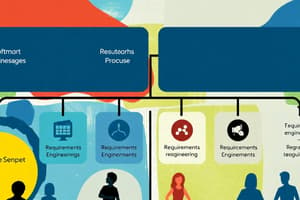Podcast
Questions and Answers
The requirements engineering process includes requirements elicitation, specification, and validation.
The requirements engineering process includes requirements elicitation, specification, and validation.
True (A)
Software design and implementation are unrelated activities in the development of a system.
Software design and implementation are unrelated activities in the development of a system.
False (B)
Debugging is the process of creating new software components from scratch.
Debugging is the process of creating new software components from scratch.
False (B)
Verification and validation are processes used to ensure a system meets customer requirements and its specifications.
Verification and validation are processes used to ensure a system meets customer requirements and its specifications.
Architectural design is concerned with the individual components of a software system.
Architectural design is concerned with the individual components of a software system.
Flashcards are hidden until you start studying
Study Notes
The Requirements Engineering Process
- Establishing the necessary services and constraints on system operation and development.
- Key activities include:
- Requirements elicitation and analysis: Identifying expectations of system stakeholders.
- Requirements specification: Detailing the requirements.
- Requirements validation: Ensuring the validity of specified requirements.
Software Design and Implementation
- Transforming system specifications into executable systems.
- Key activities:
- Software design: Creating a structure that adheres to specifications.
- Implementation: Converting the design into functioning programs.
- Design and implementation are closely interconnected and often interleaved.
Design Activities
- Architectural Design: Defining the system’s overall structure, major components, and their interactions.
- Database Design: Creating data structures and their representation in a database.
- Interface Design: Defining the interfaces between different system components.
- Component Selection and Design: Finding reusable components or designing new components if necessary.
System Implementation
- Implementing software through program development or application system configuration.
- Programming often lacks standard processes and is primarily an individual activity.
- Debugging involves identifying and correcting faults in the program.
Software Validation
- Verification and validation (V&V) ensure the system meets specifications and customer requirements.
- Includes checking, reviewing processes, and system testing.
- System testing is conducted using test cases derived from the specification with actual data.
Stages of Testing
- Component Testing: Independent testing of individual components such as functions or objects.
- System Testing: Comprehensive testing of the entire system, focusing on emergent properties.
- Customer Testing: Verifying that the system meets customer needs using customer data.
Testing Phases in a Plan-Driven Software Process (V-Model)
- Structured phases to ensure systematic testing aligned with development stages.
Software Evolution
- Software is designed to be flexible and adaptable.
- As business requirements evolve, corresponding software modifications are essential.
- The distinction between development and maintenance is becoming less significant as most software requires ongoing evolution.
Studying That Suits You
Use AI to generate personalized quizzes and flashcards to suit your learning preferences.




